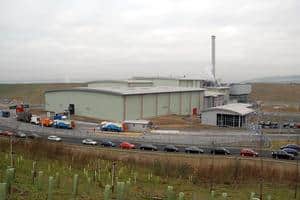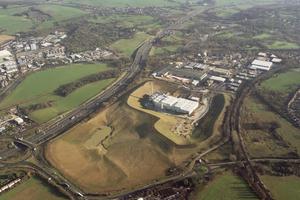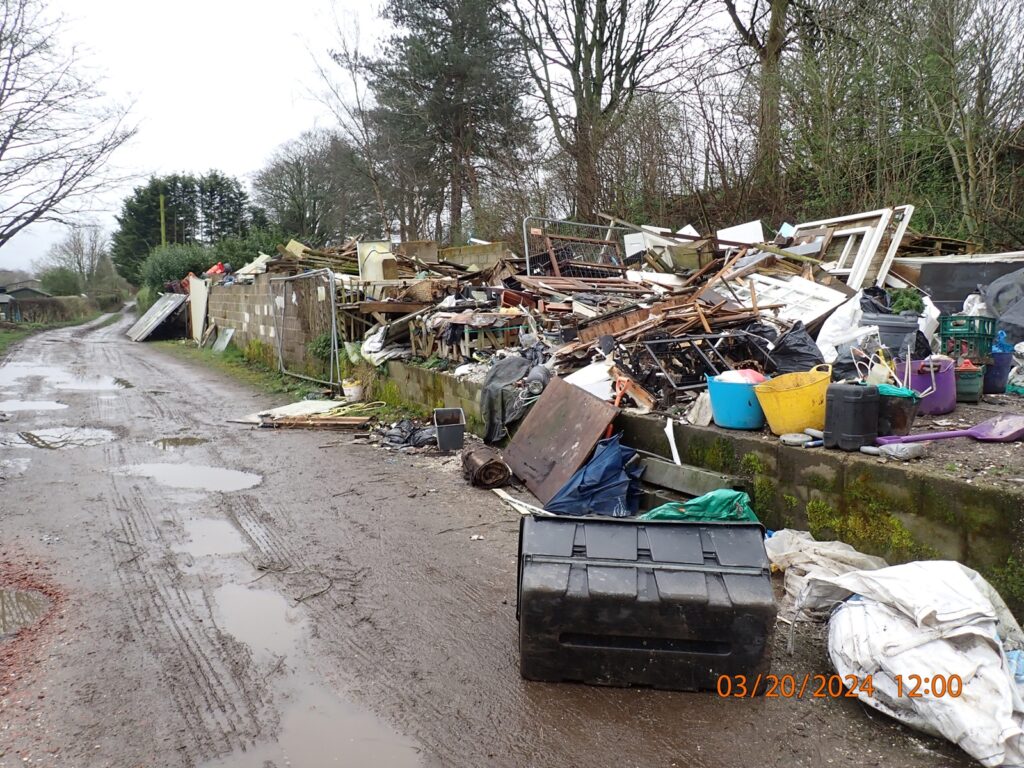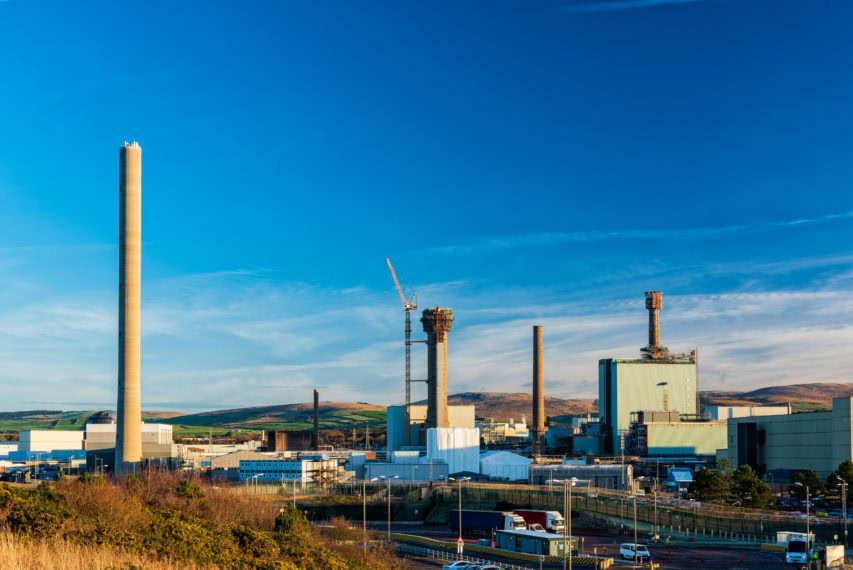Repairs have been carried out over the last few months to the three furnaces and a turbine at the Allington plant near Maidstone.
The furnace repairs, for which Kent Enviropower has said it will not be footing the bill, are due for completion in February 2007 with the drying out process now underway. Work on the turbine will not be completed until this summer which means no power will be generated before then.
Technology choice
The Allington plant is unique when considered in terms of the process it uses to burn the household waste and the size of the project. There is another waste incinerator using fluidised bed technology of a form different to Allington at Baldovie, Dundee which has a much lower throughput. (see below for a definition of fluidised bed technology).
Instead of the traditional moving grate process seen in the UK's mass burn incinerators, Allington uses a fluidised bed system. Despite the problems at the plant, Kent Enviropower remains firm in its belief that the technology is fully appropriate for UK residual waste. It rejects any criticism of the choice of fluidised bed technology, which, it points out, is different to earlier industry designs and uses the Lentjes Rowitec form of the process.
Nevertheless, the suitability of the process at Allington has been discussed on many occasions. Recently Paul Rackham, who founded Waste Recycling Group in 1983 (and is no longer involved with the business) told letsrecycle.com that he had “a lot of reservations about fluidised bed technology. My research indicated that on the continent it had a lot of downtime and any contract would need appropriate guarantees and performance bonds.”
Mr Rackham adds that the Dundee incinerator which also uses fluidised bed technology has suffered problems: “I am not opposed to new technology but I can only go on the research and my own homework and I was more in favour of moving grate technology.”
Mr Rackham also made the point that he understood the choice of technology at Allington had been made by Kent county council and noted that one of its former waste chiefs had been briefed to research new technologies.
A spokesman for Conservative-controlled Kent county council told letsrecycle.com that the waste chief involved “retired a few years ago.” He added: “The decision to go-ahead with this type of technology lay with the previous administration which was a Lib-Lab coalition.”
Other viewpoints aired to letsrecycle.com came from the chief executive of one of the UK's top waste management companies and from an engineer in the sector.
The chief executive said: “Moving grate is the popular technology. Fluidised bed is smaller and the category of waste is important – the key is the preparation of the waste.”
The view of the engineer was that he hoped the project turned out to be successful to show that fluidised bed would work well in the UK, with the initial delays eventually seen as small in terms of the lifetime of the project. He added: “My real concern would be that the problems at Allington might give waste to energy a bad name.”
Kent decision
The smaller Dundee plant at Baldovie, which Kent councillors were aware of in making their decision, suffered a number of problems early in this decade and repairs costing millions of pounds have been undertaken. Operational levels in 2003-04 and beyond were around 65%. It still uses a fluidised bed system to handle 105,000 tonnes of waste per annum and has since undergone a total refurbishment. Work has included upgrading the bed nozzles and replacing the boiler walls, the company told letsrecycle.com.
An explanation of the current system comes from Paul Andrews, managing director of Kent Enviropower. He heads up the Allington project and is also WRG's director of operations for energy from waste. Qualified as a design engineer, Mr Andrews has waste industry experience which started with Shanks in 1991 where he worked on the Calvert Two landfill site gas project.
He explains that the decision to go down the route of the fluidised bed system was because for the final disposal contract for Kent it specified the type of technology required which would help it earn grants under the NFFO reward scheme for non-fossil fuels technology.
The contract allows financial certainty over the disposal of waste
Paul Andrews, Kent Enviropower
The contract was won by Hanson Waste Management, later bought by WRG, which came up with proposals to handle recyclable materials and residual waste at Allington. The decision to choose a fluidised bed solution was also influenced by the decision of Dundee council to opt for this type of plant but following the operational problems at Dundee, Kent county council pursued the Lentjes Rowitec system which used a Madrid plant as the reference plant. ( In Madrid, Lentjes – the turnkey contractor for Allington – had been brought in to modify the plant and improve on the control system after securing a licence arrangement for the technology from the Ebara Corporation.)
Various locations for the Kent plant were cofnsidered with Allington selected as it matched the criteria set by the county council for the site including being close to junction 5 of the M20 and being set in a disused quarry which helped it not to impact too heavily on local communities, explains Kent Enviropower's communications manager, Fiona MacIntosh, of consultancy PPS. She adds: “A community liaison committee was formed, chaired by a local headmaster, and the committee has been one of the real successes of the project.”
Construction
Construction of the Allington facility started in April 2004 with buildings and civils works subcontracted to German construction firm Hochtief which has reported substantial losses on its contract. Commissioning with waste deliveries began in May 2006 with increasing volumes of waste delivered with the plant due to reach full capacity by November 2006.
Once operational the plant is expected to process about 50% of Kent's residual waste reducing the volume to landfill from 100% to 48%. This is likely to give county figures of 36% recycling/composting; 33% energy recovery; and 31% landfill.
Mr Andrews says: “The contract allows financial certainty over the disposal of waste and the minimising of transport costs also gave the county more surety over price. This is a fixed price disposal contract over 25 years with various other mechanisms linked to it.”
Problems
Problems arose soon after commissioning of the facility. In July 2007 councils learnt of technical problems and that the plant had been shut-down, leading to significant problems for some local authorities.
Kent county council issued a statement to local authorities in its area saying: “The Allington energy from waste plant has been affected by a problem to the rowitecs (burners) with evidence of cracking of the refractory linings. As a result, the linings will be renewed, delaying commissioning by several months.
“During commissioning, Kent County Council is committed to provide refuse on request to Kent Enviropower Limited to allow commissioning and testing at the plant. The current work to the refractory lining is scheduled to be complete in early February 2008 and will be followed by further commissioning tests before takeover of the plant.”
Kent Enviropower itself stated: “During the tests an issue has arisen with the insulating lining in the furnaces (the chambers where rubbish will be burned). That lining is being stripped off and replaced.”
Details of the second problem, to the turbine, do not appear to have been publicised.
Council implications
Kent Enviropower says that there is no extra cost to Kent because of the shutdown. This appears to be because the charge for using the Allington plant would be higher than Kent's current landfill costs in the short term. Mr Andrews explains: The costs to the council are similar. In the longer term the gate fee is probably less than landfill. The original driver for Kent was that they recognised they would have to pay more for construction of the site with the classic efw price remaining stable throughout the life of the contract.”
The company considers that Kent, “by the building of Allington, are in a very strong position. If they were a local authority trying to secure a contract now it would not have been as competitive as it was a few years ago.”
This means, therefore, that all the costs to date are incurred either by Kent Enviropower or its contractors. This includes repairs and also the lost income from the county council which helps to service the company's debt. Discussions have taken place over who meets the costs of the delays ad repairs. Kent Enviropower said: “”Kent Enviropower Ltd can confirm that there is no additional cost to the taxpayers of Kent relating to the last years' issues with the furnace linings at Allington Quarry waste management facility. In addition, it can be confirmed that Kent Enviropower and its parent company Waste Recycling Group will not have to find additional funds to meet these costs.”
Damages
Little specific detail of actions are being disclosed because of the sensitivity of the situation but delay damages and repair damages are involved. The main contractor is Woking-based Lentjes UK, renamed from Lurgi in 2006 which has a fixed-price contract with Kent Enviropower. Until December 2007 Lentjes was German-owned but the complete group was then sold to the Austrian energy and environment division of A-Tec Industries AG.
Asked about the extra costs and involvement of banks supporting the project, Mr Andrews notes: “Kent Enviropower has a fixed price contract with Lentjes. The banks have a clear agreement with Lentjes which enables repair work to go forward. They are taking an interest in anything that is later than expected.”
Crucial to the costs issue is that the problems have been uncovered during the commissioning stage. And, the waste disposal work is not a factor at present, as Mr Andrews explains: “Once the contract starts in its full operational phase, the risk for disposal of the waste then transfers to Kent Enviropower.”
Repairs
Mr Andrews says that the decision to repair the plant soon after trials started made sense. “Clearly to bring the plant into operational phase and shutdown would not be sensible. “It is better to repair the plant first as it will run for 25 years, much better to do it now rather than enter the operational phase.”
The Allington plant includes:
-
Materials recovery facility
-
3-line pre-treatment with shredders and metal separators
-
bunkers for raw waste as well as for RDF with cranes
-
3-line incineration with waste heat recovery boilers and flue gas cleaning
-
Electrical power production from steam via a condensing turbine followed by an air cooled condenser
The core of the process is the use of a fluidised bed in each of the three furnaces. In simple terms the bed is shaped like a standard pitched house roof. This has a bed of sand over it and with holes in the 'roof structure for hot air to be directed through, to create a bubbling bed of sand. This mixes with the waste and helps the waste to burn at a temperature of 850°C. Oversize items fall down slots at the side. The process is known as Rowitec and has been licensed to Lentjes by Japanese firm Ebara which is understood to have originally bought the rights to it from a UK company.
Bubbling
David Porter of Lentjes explains: “This is a bubbling bed. The origins of this in the UK started when Dundee started to go wrong. Lurgi was approached for help and had worked on the facility in Madrid. Dundee's problems were allied to the fluidised bed, but this is not the case with Allington. The type of bubbling bed design at Dundee is normally used for sludge and other homogeneous wastes.
The Rowitec process here is completely different
David Porter, Lentjes
“The Rowitec process here is completely different. Oversize material does not disrupt the process. Items which are much larger than a normal fluid bed can take, generally above 30-40 cms in size, such as exhaust pipes and sewing machines will fall down the slots at the sides, allowing it to continue operating. This avoids any need to collapse the bed and recover the items.”
Refractory
Mr Porter explained that the current problems lie with the refractory: “The problem with the refractory is in the free boards which line the upper area of the refractory.” He explains that during the commissioning process, “the refractory lifted away from the furnace wall through expansion due to a reduced number of joints.”
Repairs are now underway and this is seeing the installation of smaller panels, cast on site, with more expansion joints. This will produce new hot face linings for all three furnace with the addition of extra restraining anchors welded onto the original ties. The repairs are a huge job involving not only the installation of new hot faces to the furnaces, but also the removal of the original faces. Each furnace has 200 tonnes of linings, cast on site. This is being organised by Lentjes as main contractor. “The responsibility of the repair work sits with Lentjes,” adds Mr Porter.
So, the clear message from Lentjes is that the fluidised bed itself is working well and it is the linings above the Rowitec fluidised bed which are having to be replaced. However, other sources close to the project suggest that the situation could be less clear-cut than this and there is discussion of the process including temperatures and the waste.
For Kent Enviropower, Ms Macintosh emphasises: “The issue with the linings is totally different from the fluidised bed.”
Turbine
The second major problem to hit Allington was the lubrication system in the turbine which generates power. The plant can operate without power generation but it is a significant setback and will take several months to repair, including taking the impellor out, and because of the need to order special parts from manufacturer Siemens. Local reports suggest that lubrication may have been missed because warning lights did not operate and it is understood that contractual liability negotiations are underway over this issue.
Completion of turbine repairs are not due until mid-2008 so if the plant does become operational from February 2008, steam generated will simply be dumped until the summer, rather than being used to power turbines.
The future
Looking ahead, Mr Andrews says: “The next step will be for completion of the furnace repairs and the plant moving to the trial stage again.”
It looks unlikely that the plant will be fully operational until the autumn of 2008, assuming repairs are successful. Mr Andrews explains that the original plan was for the company to start trials in October 2006 which would mean it working at full operational capacity, and Kent Enviropower taking it over, in February 2007.
And, he also considers that the difficulties need to be put into perspective. “This is a 25-year project and any major project faces delays, from Wembley to the Millennium Dome. It is all relative in terms of the timeframe we are working on.”
However, on the delays he adds: “Given all the people who have worked very hard on this it is disappointing for us all.”
Fluidised bed – a definition
Source: Cardiff University Waste Research Station http://www.wasteresearch.co.uk/ade/efw/fluidised.htm
“This type of combustion (a simple modification to mass burn) involves the waste to be used as fuel being suspended by an updraft supply of air and kept 'fluidised' on a base of small inert particles such as sand. The waste is effectively mixed with the hot bed material to ensure it is fully burned. Fluidised bed combustors come in many different designs, for example circulating and bubbling beds (indeed there are also designs for application to gasification and pyrolysis technologies). They all require the waste to be of uniform size which signifies that a pre-treatment shredding stage is required which adds to the cost of the process. Conversely, savings are made as compared to basic incineration systems that spring from the possibility of including lime in the combustor material to inhibit the production of acid pollutants. Consequently, there is no need for the expensive bolt-on air pollution control system typical to mass burn incinerators which remove them once in the flue gases. These factors balance out so the cost per tonne of processing is not markedly different between the two processes. However, fluidised bed systems are typically smaller so they may befit a community smaller than is needed to maintain a mass burn system. The shredding process can be interwoven with materials recycling, however while ferrous metals can be easily separated, much of the rest of the material will be lost and a large proportion will not be suitable for recycling, for example paper which needs to be kept clean.”









Subscribe for free